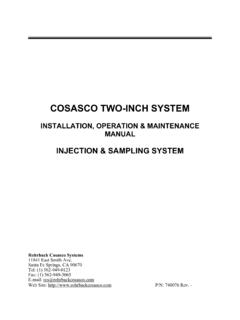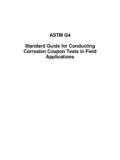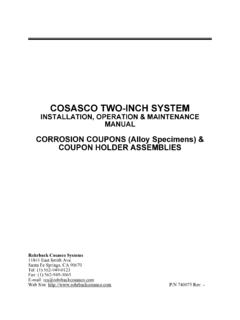Transcription of Corrosometer Probe Selection Guide - Cosasco
1 Rohrback Cosasco Systems, Cosasco Systems, Inc. - The World Leader in Corrosion Monitoring Systems Specifications subject to change without notice Corrosometer Probe Selection Guide GENERAL APPLICATIONS Corrosometer probes and instruments determine metal loss from corrosion or erosion by the electrical resistance method. This method may be used in virtually any environment except liquid metals or some conductive molten salts. Corrosometer instruments directly measure the metal loss on Corrosometer probes. Plotting metal loss as a function of time permits corrosion rate to be determined. The slope of the curve represents the average corrosion rate over the selected interval.
2 PRINCIPLE OF OPERATION The electrical resistance of a section of electrically conductive material such as a metal may be expressed by the formula. R = L A where: is the intrinsic electrical resistivity of the material L is the length of the section A is the cross-sectional area of the section The intrinsic resistivity, , varies from alloy to alloy and is temperature dependent. For a give alloy at constant temperature, the electrical resistance of a fixed-length specimen increases as the cross-sectional area decreases. Consequently, the measurement of electrical resistance may be used to determine metal loss.
3 Compensation for change of resistivity with temperature is achieved by the use of a reference element protected from the corrosion process. As the electrical resistance of the measurement element increases with temperature, so does the electrical resistance of the reference element. However, the resistance ratio of the two elements remains unchanged, thereby providing automatic compensation for temperature changes. Since Corrosometer probes have a lower electrical resistance than the connecting cables and connectors, separate electrical current and voltage monitoring wires must be used. By energizing the Probe elements with the same electrical current, the resistance ratio of the elements is determined by measuring the voltage ratio of the elements.
4 Probe MOUNTING CONFIGURATIONS There are a wide variety of Corrosometer probes to match various applications. The major Probe categories are as follows. 1. Internal process monitoring probes a. Removable under system pressure b. Non-removable under system pressure 2. Laboratory probes 3. External and structural monitoring probes 4. Environmental monitoring probes Rohrback Cosasco Systems, Inc. - The World Leader in Corrosion Monitoring Systems Specifications subject to change without notice In general the Corrosometer probes have sensing elements made of the metal or alloy for which corrosion data is required. The Probe bodies may be of the same alloy, but thicker, or of a higher, less corrosive alloy.
5 Details are given on the data sheet for each model Probe . Internal Process Monitoring Probes Removable Under System Pressure Probes that are removable under system pressure are particularly useful to enable inspection or change out of probes without shutting down or isolating the system. Two systems are available depending on the pressure. a. RETRACTABLE SYSTEM for pressures up to 1,500 psi. b. RETRIEVABLE SYSTEM for pressures up to 3,600 psi and 6,000 psi. RETRACTABLE process probes are introduced into the system through a stuffing box mounted external to a valve. A specially-designed retracting device is available for insertion or removal of probes at pressures too high to permit safe operation by hand (above 150 psi requires over 50 lb.)
6 Insertion force). RETRIEVABLE process probes are sealed into the system in a Cosasco access fitting. A separate Cosasco service valve and retriever is used for insertion and removal of the probes under system pressures. Internal Process Monitoring Probes Fixed Type (Non-removable under system pressure) Probes which are not removable under system pressure are sometimes used for reasons of economy or special process limitations. These may be mounted with a flange or NPT threaded connection. NPT connections are available with fixed or adjustable length. CORROSION MEASUREMENT ELEMENTS Several Corrosometer element forms are available. Selection of the most suitable element form and specially the correct Probe sensitivity is important to obtaining good quality corrosion data.
7 Elements are available in a wide variety of alloys; consult the Probe data sheets for those available in each type. Strip, Tube, & Wire Loop Elements These elements are generally more economical and available in a wider range of alloys than for other element forms. Two forms of element seals are available to protect the reference element within the Probe body. Glass-to-metal seals provide the highest seal integrity and are generally suitable for process fluid in the range of 0-9 pH and temperatures up to 500 degrees F. They are not suitable for fluids containing fluoride ions which attack glass, ceramics and epoxies. Teflon coating and ceramic fill provide the alternative seal of the reference element in loop elements.
8 Cylindrical Elements These probes have the element directly welded to the Probe body to provide the highest integrity seal for aggressive environments. They provide a large surface area for measurement, have the fastest dynamic response to temperature transients, and are the least susceptible to the effect of any conductive deposits (such as Iron Sulfide) where present. The construction enables these probes to be used in environments in pH range 0-14, at temperatures up to 500 degrees F (260 degrees C). A high temperature model is also available for temperatures above 50 degrees F. The body of the cylindrical element Probe is normally supplied in the same alloy as the element to prevent the effects of possible galvanic corrosion between the Probe body and Probe element.
9 Flush Elements Flush element probes are available where it is particularly necessary to monitor localized wall effects, or where protrusion into the line would cause damage to the Probe ; for example, during pigging operations. Rohrback Cosasco Systems, Inc. - The World Leader in Corrosion Monitoring Systems Specifications subject to change without notice Rohrback Cosasco Systems, Inc. Probe MATERIALS Care should be taken to check that the wetted Probe components are compatible with the process fluid. Pressure ratings are specified on this basis. Corrosometer probes are designed with pressure retaining capability beyond the Probe element. However, the pressure rating may be impaired if the Probe is not removed within a reasonable period of time after expiration of the Probe element.
10 Probe Body and Wetted Parts For loop element and flush element probes, the standard body materials are 304 and 316 stainless steel. Cylindrical element probes generally have wetted parts of the same alloy as the Probe element. Probe Element Seals Telfon is rated to 500 degrees F (260 degrees C) maximum. Glass seals are rated to 500 degrees F (260 degrees C) maximum in a pH range of less than 9. For standard cylindrical probes, the process operating temperature is limited to 500 degrees F (260 degrees C) by internal Teflon insulators. For high temperature cylindrical element probes, internal insulation is ceramic. Probe Fill Material Standard Probe fill materials are ceramic or epoxy.


